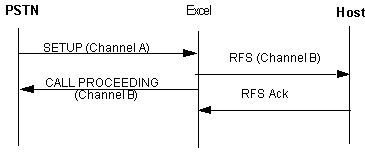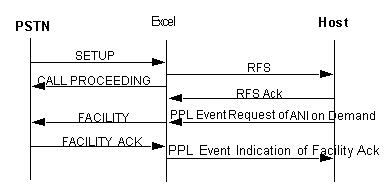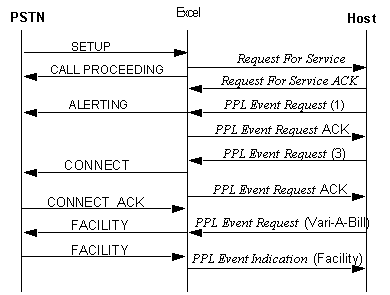
You are here: CSP Developer’s Guide: Common Channel Signaling > 8 ISDN > Other Optional ISDN Configurations
Other Optional ISDN Configurations

Overview
Besides D channel backup and Information Elements, there are other optional configurations that are available with ISDN PRI.
This section outlines the configurations for:
• B channel negotiation
• ANI on demand
• Vari-a-bill billing
B Channel Negotiation
ISDN cards support B channel negotiation on incoming calls as defined in Lucent TR41459 for both E1 and T1 cards. This feature allows the user receiving the incoming call (SETUP) to negotiate for the selection of the B channel. Only B channels controlled by the same D channel are considered for the selection procedure.
Call Flow
The SETUP message indicates the channel as either exclusive (does not accept an alternative) or preferred (any alternative is acceptable). If the channel is specified as preferred, but the user cannot grant the indicated channel, it selects any other B channel associated with the D channel. If the channel was specified as exclusive, no negotiation of the selection of the B channel is permitted and the call is rejected.

ISDN Interface Configure enables feature
B channel negotiation is enabled using the ISDN Interface Configure message. The following selection modes are provided:
• Linear Clockwise (default)
• Linear Counter-Clockwise
• Circular Clockwise
• Circular Counter-Clockwise
For NFAS, B channels on the same facility are selected before channels on other facilities.
Sample usage of feature
The following example shows the use of the ISDN interface Configure message to select the B channel negotiation mode.
X->H FE [00 0F] [00 60] 00 00 01 00 01 0D 03 00 00 17 06 00 01]
|
Byte |
Field Description |
Value and Indication |
|---|---|---|
|
0 |
0xFE |
|
|
1, 2 |
Length |
0x000F (15) |
|
3, 4 |
Message Type |
0x0060 |
|
5 |
Reserved |
0x00 |
|
6 |
Sequence Number |
0x00 |
|
7 |
Logical Node ID |
0x01 |
|
8 |
AIB |
0x00 (Single Entity) |
|
9 |
Number of Address Elements |
0x01 |
|
10 |
Address Element Type |
0x0D (Channel) |
|
11 |
Address Data Length |
0x03 |
|
12, 13 |
Address Data[0] Logical Span |
0x0000 (Span 0) |
|
14 |
Address Data[1] Channel |
0x17 (Channel 23) |
|
15 |
Entity |
0x06 (B Channel Selection Mode) |
|
16 |
Data[0] Reserved |
0x00 |
|
17 |
Data[1] |
0x01 (Linear Clockwise) |
|
18 |
Checksum |
0xCS (not shown in trace) |
ANI on Demand
ISDN cards support the Automatic Number Identification (ANI) on Demand feature as specified in Lucent TR41459. This feature allows the host to request the Calling Party Number from networks that support ANI such as AT&T MultiQuest.
A PPL Event Request message of ANI on Demand (0x21) must be sent from the host immediately after receiving the Request For Service message from the CSP. If the call has already been answered, a NACK of 0xC0 is returned by the CSP.
If successful, a FACILITY message is sent to the network requesting the ANI. A PPL Event Indication message of FACILITY ACKNOWLEDGE is returned containing the ANI information in a Calling Party IE or Network-specific Facility IE. If the ANI is not supported by the network or is not available, a PPL Event Indication message of FACILITY REJECT is returned by the CSP.
See the Lucent TR41459 specification for detailed information.
ANI on Demand Call flow
The figure below shows a call flow using the PPL Event Request message to implement the ANI On Demand feature.

Vari-A-Bill Billing
ISDN cards support the Vari-A-Bill feature as specified in Lucent TR41459. This feature allows the host to request a change in billing for an incoming call. You can use this feature after a call has been answered and only if the SETUP message indicates that the network supports the flexible billing service.
Enabling Vari-a-Bill
To enable Vari-a-Bill, send a PPL Event Request message with a PPL Event of Vari-A-Bill (0x20), specifying the new billing information in a Vari-A-Bill Data ICB (0x12). The CSP sends a FACILITY message to the network requesting the billing change.
If the call is not in the answered state, then the feature is not supported and a NACK of 0xC0 is returned by the CSP. A PPL Event Indication of FACILITY is returned from the network indicating whether the billing change was successful. See the Lucent TR41459 specification for detailed information.
Call Flow
The following call flow shows the use of the PPL Event Request message to implement the Vari-A-Bill feature.

Example
The following example shows the PPL Event Request message to implement Vari-A-Bill billing and change the billing rate.
Trace X->H FE [00 1E] [00 44] 00 00 01 00 01 0D 03 00 00 00 [00 05] 00 20 01 02 10 0A 01 12 07 01 90 30 31 32 35 36
|
BYTE |
Field Description |
Value and Indication |
|---|---|---|
|
0 |
Frame |
0xFE |
|
1, 2 |
Length |
0x001E |
|
3, 4 |
Message Type |
0x0044 |
|
5 |
Reserved |
0x00 |
|
6 |
Sequence Number |
0x00 |
|
7 |
Logical Node ID |
0x01 |
|
8 |
AIB |
0x00 (Single Entity) |
|
9 |
Number of Address Elements |
0x01 |
|
10 |
Address Element Type |
0x0D (Channel) |
|
11 |
Address Data Length |
0x03 |
|
12, 13 |
Address Data[0] Logical Span |
0x0000 (Span 0) |
|
14 |
Address Data[1] Channel |
0x00 (Channel 0) |
|
15, 16 |
0x0005 (L3P Call Reference) |
|
|
17, 18 |
PPL Event |
0x0020 (Vari-A-Bill) |
|
19 |
ICB Count |
0x01 |
|
20 |
ICB Type |
0x02 (Data) |
|
21 |
ICB Subtype |
0x10 (Formatted IE) |
|
22 |
ICB Data Length |
0x0A |
|
23 |
ICB Data[0]Number of IEs To Follow |
0x01 |
|
24 |
ICB Data[1] IE Type |
0x12 (Vari-a-bill Data) |
|
25 |
ICB Data[2] IE Length |
0x07 |
|
26 |
ICB Data[3] Invoke ID |
0x01 |
|
27 |
ICB Data[4] Billing Type |
0x90 (New Rate) |
|
28 |
ICB Data[5] Billing Data (Hundreds) |
0x30 |
|
29 |
ICB Data[6] Billing Data (Tens) |
0x31 |
|
30 |
ICB Data[7] Billing Data (Ones) |
0x32 |
|
31 |
ICB Data[8] Billing Data (Tenths) |
0x35 |
|
32 |
ICB Data[9] Billing Data (Hundredths) |
0x36 |
|
33 |
Checksum |
0xCS (not shown in trace) |